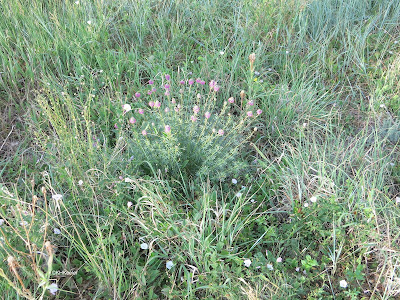Purple prairie clover is a very pretty native wildflower. It stands about two feet tall (sometime 3'), in a compact clump. The flowers are light purple and it will flower all summer. Most abundant in the central Midwest, its native range included meadows in the eastern U.S. and forest gaps in the mountain West, moist grasslands in the desert Southwest, and warmer sites in southern Canada. Today, it has been planted even more widely, but its native populations in Michigan and Ohio are presumed extinct, and it is endangered in Tennessee.
 |
| purple prairie clover Dalea purpurea |
Purple prairie clover, Dalea purpurea, is a legume, in the pea family Fabaceae, as the name clover suggests. It forms a symbiotic mutualism with nitrogen-fixing bacteria in its roots, trading carbohydrates for sugars with the bacteria, and scattering excess fixed nitrogen, essential to plants generally, into the soil, makng the soil richer and more nutritious than before purple prairie clover was there.
 |
| purple prairie clover, Dalea purpurea |
 |
| purple prairie clover Dalea purpurea (center) |
Although widespread, purple prairie clover is especially a plant of--as its name says--prairies, North American grasslands. And, as you would expect for a native, it will spread if the conditions are good, but it isn't aggressive ("weedy.")
Prairies are dry. Purple prairie clover seedlings quickly send a water-seeking tap root deep into the soil. The roots of purple prairie clover plants will go down more than 6' into the ground and spread through easily 18 cubic feet of soil.
 |
| Diagram of purple prairie clover, Dalea purpurea. |
Measuring the length of prairie plant roots is difficult. Lots of what we know is due to the work of J. E. Weaver (1884-1966, bio), Professor of Botany at the University of Nebraska in Lincoln. Weaver, with a career spanning the Great Drought, became The authority on native grasslands and their response to drought, above and below ground. We always say "work of J. E. Weaver," because he published the papers. But when I joined the University of Nebraska in 1975, there were still people who remembered Weaver, and they were clear that most of those amazing roots were excavated by Weaver's students. That makes sense; even fine loess soils are hard to dig in and roots wander around in three dimensions. It was tedious hard work diagramming roots. I've tried to follow roots of plants in the much easier-to-dig sands of the the Nebraska Sandhills, and you lose them, break them, follow some other species' root...worth doing but aggravating. What Weaver and students produced were impressive diagrams of root lengths, showing prairie plants are 1/2 to more than 3/4 underground. Given how difficult it is to get this information--find a healthy plant in a place you can dig, dig a pit deep enough to get all the roots, probably take it back to the lab in a big box (heavy, awkward, messy) and carefully find the roots of the plant you want and not its neighbors--it isn't often repeated, so observations on a very few individual plants represent even widespread species like purple prairie clover. And we are very grateful to J.E. Weaver and students for doing the work!
 |
| purple prairie clover in a Minnesota meadow |
Purple prairie clover is edible to grazers and browsers and considered a valuable forage plant for livestock. It is in fact edible to humans; Native Americans, such as the Dakota and Oglala, made tea from the leaves, and others, the Comanche, Lakota, and Ponca, chewed the roots for the pleasant taste, basically as candy. An infusion of the root was used medicinally to keep away sickness (Pawnee), against pneumonia (Navajo) or for measles (Awaki).
Comments and corrections welcome.
References
Albertson, F. W. and G. W. Tomanek. 1965. Vegetation changes during a 30-year period in grassland communities near Hays, Kansas. Ecology. 46 (5): 714-720.
Costello, D. F. 1969. The Prairie World. Thomas Y. Cromwell, Publishing. New York.
Illinois Wildflowers. Purple prairie clover. Illinoiswildflowers.info (link) Accessed 10/26/21.
Kindscher, K. 1987. Edible Wild Plants of the Prairie. University of Kansas Press. Lawrence, KS.
Lauenroth, W. K. and P. B. Adler. 2008. Demography of perennial grassland plants: survival, life expectancy and life span. Journal of Ecology. 96 (5): 1023-1032.
League, Kevin R. 2004. Dalea purpurea. In: Fire Effects Information System. U.S. Department of Agriculture, Forest Service, Rocky Mountain Research Station, Fire Sciences Laboratory (Producer). link Accessed 10/26/21.
Moerman, D. E. 1998. Native American Ethnobotany. Timber Press. Portland, OR.
Weaver, J. E. 1954. North American Prairie. Johnsen Publishing Company. Lincoln, NE.
Kathy Keeler, A Wandering Botanist
More at awanderingbotanist.com
Join me on Facebook: https://www.facebook.com/AWanderingBotanist


No comments:
Post a Comment